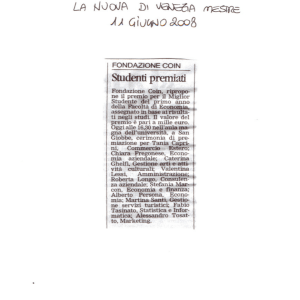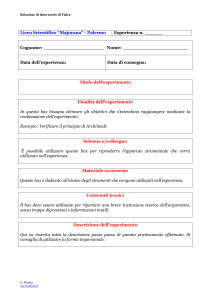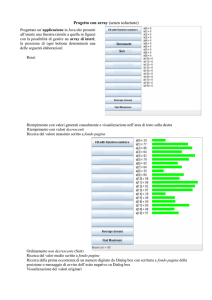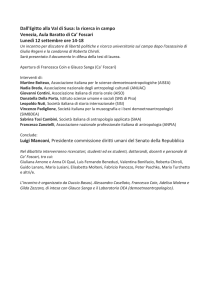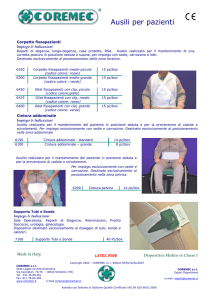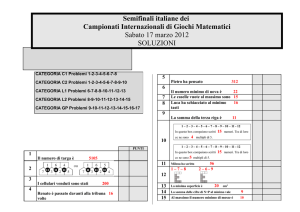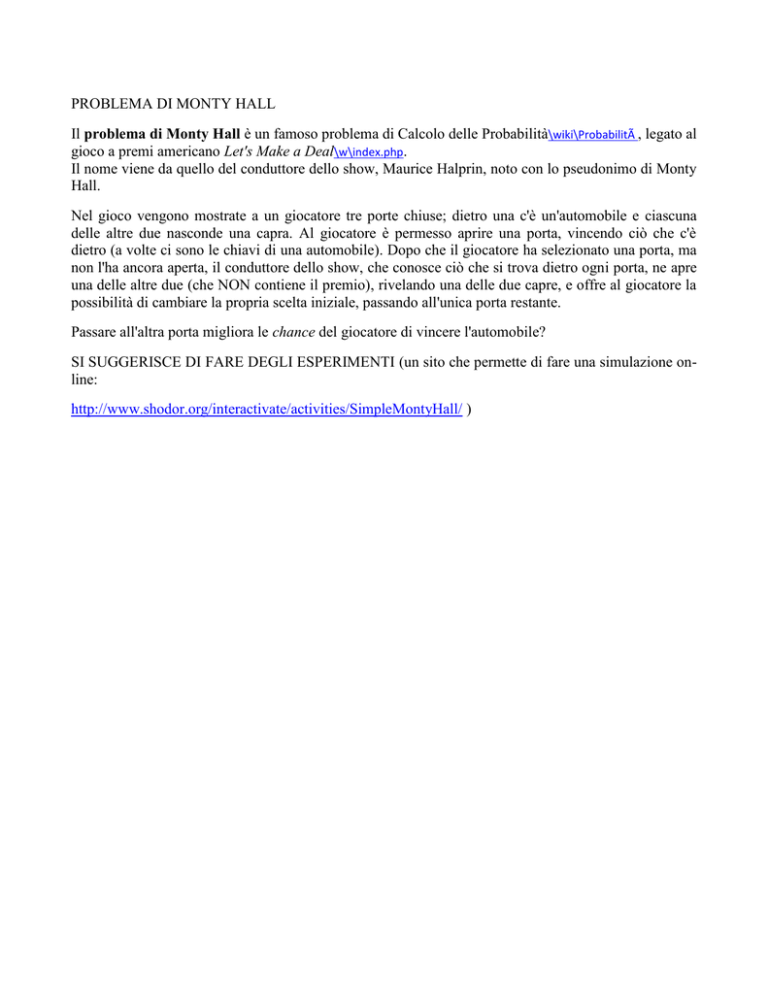
PROBLEMA DI MONTY HALL
Il problema di Monty Hall è un famoso problema di Calcolo delle Probabilità\wiki\Probabilità , legato al
gioco a premi americano Let's Make a Deal\w\index.php.
Il nome viene da quello del conduttore dello show, Maurice Halprin, noto con lo pseudonimo di Monty
Hall.
Nel gioco vengono mostrate a un giocatore tre porte chiuse; dietro una c'è un'automobile e ciascuna
delle altre due nasconde una capra. Al giocatore è permesso aprire una porta, vincendo ciò che c'è
dietro (a volte ci sono le chiavi di una automobile). Dopo che il giocatore ha selezionato una porta, ma
non l'ha ancora aperta, il conduttore dello show, che conosce ciò che si trova dietro ogni porta, ne apre
una delle altre due (che NON contiene il premio), rivelando una delle due capre, e offre al giocatore la
possibilità di cambiare la propria scelta iniziale, passando all'unica porta restante.
Passare all'altra porta migliora le chance del giocatore di vincere l'automobile?
SI SUGGERISCE DI FARE DEGLI ESPERIMENTI (un sito che permette di fare una simulazione online:
http://www.shodor.org/interactivate/activities/SimpleMontyHall/ )
Preso dalla Letter to the Editor di M. Bloxham pubblicato sulla rivistaThe American Statistician, Vol. 29, No. 1
(Feb., 1975), p. 67
TABELLA EQUIVALENTE
POSIZIONE DELLA
CHIAVE
A
SCELTA INIZIALE DEL
CONCORRENTE
A
IL CONCORRENTE
CAMBIA PORTA
C
B
A
RISULTATO
B
PORTA APERTA DAL
PRESENTATORE
B con probab 1/2
C con probab 1/2
C
A
A
C
B
A
VINCE
B
A
C
B
VINCE
B
B
B
C
A con probab 1/2
C con probab 1/2
A
B
PERDE
PERDE
VINCE
C
A
B
C
VINCE
C
B
A
C
VINCE
C
C
A con probab 1/2
B con probab 1/2
C
A
B
A
PERDE
PERDE
VINCE
PERDE
PERDE
FACCIAMO UNA TABELLA ANALOGA MA CON PROBABILITÀ DIVERSE:
ossia il presentatore sceglie sempre la porta SENZA PREMIO più vicina a lui con probabilità p e l'altra con
probabilità 1-p
(si suppone che nell'ordine le porte più vicine al presentatore siano la A, poi la B e poi la C)
POSIZIONE
DELLA
CHIAVE
A
SCELTA INIZIALE
DEL
CONCORRENTE
A
IL CONCORRENTE
CAMBIA PORTA
RISULTATO
PROBABILITA'
qqqqqqqqqq,
B
PORTA APERTA
DAL
PRESENTATORE
B con probab p
C con probab 1-p
C
C
B
A
PERDE
PERDE
VINCE
A
A
C
B
A
VINCE
1/9
B
A
C
B
VINCE
1/9
B
B
B
C
A
C
A
B
PERDE
PERDE
VINCE
C
A
B
C
VINCE
1/9
C
B
A
C
VINCE
1/9
C
C
A con probab p
C con probab 1-p
A con probab p
B con probab 1-p
B
A
PERDE
PERDE
1/9 p
1/9 (1-p)
1/9
1/9 p
1/9 (1-p)
1/9
1/9 p
1/9 (1-p)
CASO 1 (la probabilità p e' NOTA, ho scelto la porta A e mi viene mostrata la porta B )
P(Vincere, cambiando la porta dato che ho scelto la porta A e mi è stata mostrata la porta B)
= P(la chiave sia in C , ho scelto la porta A e mi è stata mostrata la porta B)/P( ho scelto la porta A e mi è stata
mostrata la porta B)
= P({(C,A,B)}/P({(C,A,B), (A,A,B)})= (1/9)/(1/9+1/9p)=1/(1+p)
Si noti che la funzione f(p)=1/(1+p) è decrescente in p e vale f(0)=1 f(1)=1/2
che comunque è sempre maggiore o uguale a 1/2 e quindi maggiore o uguale a 1/3 che è la probabilità che io
abbia "azzeccato" al primo colpo
NB nel caso in cui p=/12 viene f(1/2)=2/3
CASO 2 (la probabilità p e' NOTA, ho scelto la porta A e mi viene mostrata la porta C).
P(Vincere, cambiando la porta dato che ho scelto la porta A e mi è stata mostrata la porta C)=
=P(la chiave sia in B , ho scelto la porta A e mi è stata mostrata la porta C)/P( ho scelto la porta A e mi è stata
mostrata la porta C)
=P({(B,A,C)}/P({(B,A,C), (A,A,C)})= (1/9)/(1/9+1/9(1-p))=1/(1+1-p)=f(1-p) che comunque è sempre maggiore o
uguale a 1/2 e quindi maggiore o uguale a 1/3 che è la probabilità che io abbia azzeccato al primo colpo
-------------------------------------------------------------------------------------------------------------------------------------------QUESTA OSSERVAZIONE SI PUO' OMETTERE
Nei casi precedenti si è supposto che la probabilità p fosse nota:
se invecela probabilità p NON e' NOTA e considero invece che non so con quale probabilità sceglie la porta più
vicina, ma penso che scelga p con probabilità uniforme si può ragionare come segue
nel CASO 1 l'integrale di 1/(1+p) per p che varia tra 0 e 1 e viene quindi log 2 = 0,693147
[l'integrale indefinito di 1/(1+p) è log(1+p) ]
e viene lo stesso risultato nel caso 2 in quanto basta fare un cambio di variabile da (1-p) a q e 1
[l'integrale di 1/(1+1-p) per p che varia tra 0 e 1 è uguale all'integrale di 1/(1+q) per q che varia tra 0 e 1]
Bertrand's box paradox
From Wikipedia, the free encyclopedia http://en.wikipedia.org/wiki/Bertrand%27s_box_paradox
Jump to: navigation, search
Bertrand's box paradox is a classic paradox of elementary probability theory. It was first posed by
Joseph Bertrand in his Calcul des probabilités, published in 1889.
There are three boxes:
1. a box containing two gold coins,
2. a box with two silver coins, and
3. a box with one of each.
After choosing a box at random and withdrawing one coin at random, if that happens to be a gold coin,
it may seem that the probability that the remaining coin is gold is 1⁄2; in fact, the probability is actually
2
⁄3. Two problems that are logically equivalent are the Monty Hall problem and the Three Prisoners
problem.
In a 1950 article, Warren Weaver introduced a simple way to conduct the experiment on people: the
boxes are replaced by cards, and gold and silver coins are replaced by red and black markings, one
marking placed on each of the two faces of each card. In what Martin Gardner has called the threecard swindle, a card is drawn from a hat, and if a red mark is shown, the dealer bets the victim even
money that the other side is also red. The victim is convinced that the bet is fair, but the dealer makes
money in the long run by winning 2⁄3 of the time.
These simple but slightly counterintuitive puzzles are used as a standard example in teaching
probability theory. Their solution illustrates some basic principles, including the Kolmogorov axioms.
Contents
[hide]
1 Box version
2 The paradox as stated by Bertrand
3 Card version
o
3.1 Preliminaries
o
3.2 Solutions
3.2.1 Intuition
3.2.2 Labels
3.2.3 Bayes' theorem
3.2.4 Eliminating the white card
3.2.5 Symmetry
3.2.6 Experiment
4 Related problems
5 Notes and references
[edit] Box version
There are three boxes, each with one drawer on each of two sides. Each drawer contains a coin. One
box has a gold coin on each side (GG), one a silver coin on each side (SS), and the other a gold coin on
one side and a silver coin on the other (GS). A box is chosen at random, a random drawer is opened,
and a gold coin is found inside it. What is the chance of the coin on the other side being gold?
The following reasoning appears to give a probability of 1⁄2:
Originally, all three boxes were equally likely to be chosen.
The chosen box cannot be box SS.
So it must be box GG or GS.
The two remaining possibilities are equally likely, so the probability that the box is GG, and the
other coin is also gold, is 1⁄2.
The flaw is in the last step. While those two cases were originally equally likely, the fact that you could
not have found a silver coin if you had chosen the GG box, but could if you had chosen the GS box,
means they do not remain equally likely. Specifically:
The probability that GG would produce a gold coin is 1.
The probability that SS would produce a gold coin is 0.
The probability that GS would produce a gold coin is 1⁄2.
So the probability that the chosen box is GG becomes:
_________________________________________________________________________________
ATTENZIONE: la formula precedente è errata nel senso che la prima frazione non
significa nulla
bisognerebbe invece scrivere CORRETTAMENTE: se GG indica l'evento "viene scelta la scatola che
contiene due monete d'oro", SS indica l'evento "viene scelta la scatola che contiene due monete
d'argento", SG indica l'evento "viene scelta la scatola che contiene una moneta d'argento ed una
d'oro" e infine G_1 indica l'evento "la prima moneta estratta è d'oro"
P(GG|G_1)=P(G_1|GG)P(GG)/[ P(G_1|GG)P(GG)+ P(G_1|SS)P(SS)+ P(G_1|SG)P(SG)]
= P(G_1|GG)/[ P(G_1|GG)+ P(G_1|SS)+ P(G_1|SG)]=1/[1+0+1/2]=1/(3/2)=2/3
_________________________________________________________________________________
The correct answer of 2⁄3 can also be obtained as follows:
Originally, all six coins were equally likely to be chosen.
The chosen coin cannot be from drawer S of box GS, or from either drawer of box SS.
So it must come from the G drawer of box GS, or either drawer of box GG.
The three remaining possibilities are equally likely, so the probability that the drawer is from
box GG is 2⁄3.
Alternatively, one can simply note that the chosen box has two coins of the same type 2⁄3 of the time.
So, regardless of what kind of coin is in the chosen drawer, the box has two coins of that type 2⁄3 of the
time. In other words, the problem is equivalent to asking the question "What is the probability that I
will pick a box with two coins of the same color?".
Bertrand's point in constructing this example was to show that merely counting cases is not always
proper. Instead, one should sum the probabilities that the cases would produce the observed result;
and the two methods are equivalent only if this probability is either 1 or 0 in every case. This
condition is correctly applied in the second solution method, but not in the first.
[edit] The paradox as stated by Bertrand
It can be easier to understand the correct answer if you consider the paradox as Bertrand originally
described it. After a box has been chosen, but before a drawer is opened, the probability is 2/3 that the
box has two of the same kind of coin. If opening a drawer to show a gold coin changes this probability
to 1/2, showing a silver coin the same way would also change it to 1/2. And if it changes to 1/2 no
matter what kind of coin is shown, the probability has to be 1/2 even if you don't show a coin. Since we
know it is 2/3, not 1/2, there is an apparent paradox. It can be resolved only by recognizing how
observing a gold coin changes the probability that the box is GS or GG, but not GG.
Notes and references
1. ^ Bar-Hillel and Falk (page 119)
2. ^ Nickerson (page 158) advocates this solution as "less confusing" than other methods.
3. ^ Bar-Hillel and Falk (page 120) advocate using Bayes' Rule.
Bar-Hillel, Maya; Falk, Ruma (1982). "Some teasers concerning conditional probabilities". Cognition 11
(2): 109–22. doi:10.1016/0010-0277(82)90021-X. PMID 7198956.
Nickerson, Raymond (2004). Cognition and Chance: The psychology of probabilistic reasoning,
Lawrence Erlbaum. Ch. 5, "Some instructive problems: Three cards", pp. 157–160. ISBN 0-8058-4898-3
Michael Clark, Paradoxes from A to Z, p. 16;
Howard Margolis, Wason, Monty Hall, and Adverse Defaults.


